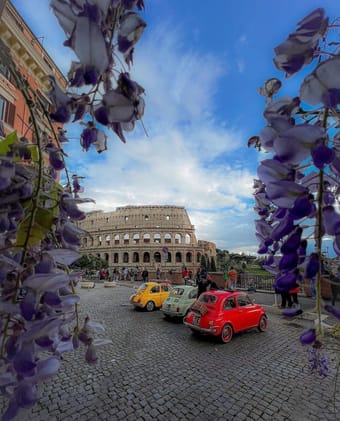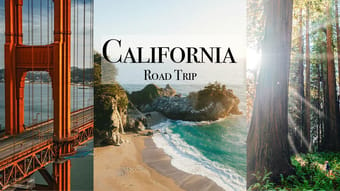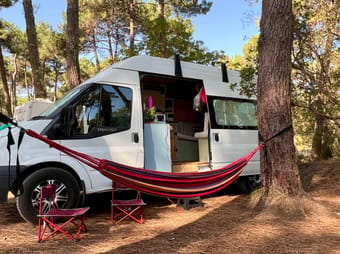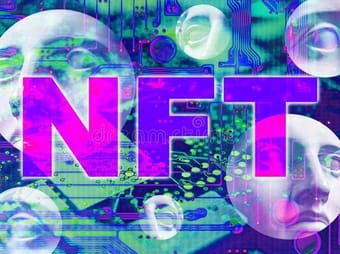Results for District 1
Ready for a weekend getaway to the San Fransisco bay area, check out this guide for how to make the best of your trip. Some of the standard tourist stops are included as well as some of our personal favorites from our visit.
Check out some of the best places to eat, things to see and do, places to shop at and how to get around the city. Over 100 recommendations and links included! San Fransisco is made up of over 19 neighborhoods with activities for all types of travelers to enjoy. Depending on what you'd like to focus on, you can base your main location out of one spot to easily get around.
This complete guide includes:
🍽️ Tons of great food options by type
🛣️ Things to do and see
Famous Houses
🚙 Travel information
🌉 Golden Gate Bridge Crossing tips
🏚️ Safety tips
Nearby Day Trip Options
Groups • Couples • Business • Female Solo • Foodie • Outdoors • Art
Free
3
Your all-in-one top scenic route for paddle boarding guide in Algarve, Portugal
Located in the southern most coastal region of continental Portugal, is the district of Faro but better known to most as the Algarve which ncludes 16 municipalities and some of Portugal´s best beach destinations. A holiday often focused around golf and the beach! Known to be Portugal´s biggest and most important tourism region.
Here’s what you’ll find in this paddle boarding route guide:
🏝️ Best Tips for Paddle Boarding / Kayaking
🏖️ Top Beaches to Visit
🤿 Places to Snorkel
🚣 Equipment Rentals
🗺️ Interactive Map
📝 Sample Itinerary - A few hours at sea along Algarve coastline paddle boarding.
**This guide will be continuously updated with more of the most scenic routes to paddle board in Algarve, Portugal. (Staying up to date with the season & trends)
If you find this information helpful, any tips are appreciated for my work :)
Backpacker • Couples • Digital Nomads • Family • Groups • Female Solo • Adventure • Budget • Outdoors • Photography • Relaxation • Sustainable/Eco
Free
1
Fascinating places in Rome - a little bit of this, a little bit of that, mixing classics with some unpopular, hidden gems!
Where to eat/drink (including a bunch of beautiful rooftops), where to shop (outlets, bespoke & made in Italy - brands you rarely find outside this country) and what to visit around (gorgeous sights included, so be sure to check them out and take lots of pictures).
Highlights:
🛵 Vespa - is an Italian luxury brand of scooters and mopeds manufactured by Piaggio. The name means wasp in Italian. An Italian icon since 1946. You’ll see many of these all over the city.
🍕 Roman style Pizza - we encounter "pizza al taglio," which means "by the cut". The scizzas, which are a type of scissors, are used to cut this pizza into square-shaped slices. This helps to maintain the structure of both the toppings and the crust. There is also “pizza bassa”, with a thin base. Roman pizza is practically the opposite to Neapolitan pizza: it is crispy and they are not afraid of toppings. A classic on all menus in Rome is the Capricciosa: topped with ham, mushrooms, olives, artichoke, an egg and tomato. Oil is added to the dough and there is much less water than the Naples version.
🥯 The maritozzo - is a classic sweet pastry, traditionally packed full of whipped cream, which has satisfied Romans for centuries. The dough-based bun is typically eaten in Rome for breakfast but can also be eaten as a hefty snack, or dessert, throughout the day.
☕️ Ristretto - is Italian for "short shots", and that's exactly what this shot of espresso brings to the table. Its main difference is that it takes a shorter extraction time, and uses less water therefore the flavor is rich and bold, and very intense.
🍧 La Grattachecca Romana - a favourite icy drink with fruity flavor; for the Romans, the grattachecca is sacred - strictly prepared by hand in the historical kiosks of the Rioni Trastevere, Testaccio and Prati, in the lively Ponte Milvio area and Trieste and Trionfale districts. Grattachecca derives, in fact, from the action with which the “ghiacciata" (ice) is produced: with a special tool, the ice is scraped off a block, called the "checca" in Roman dialect.
🛍️ When it comes to shopping, Rome can be quite the haven for designer brands, but there is no other fashion house more Roman than Valentino Garavani. The brand’s design (its famous studs) has its origins in the Renaissance architecture of Rome - the “bugnato” technique of the ancient Roman buildings. The largest Valentino store (in the world) lies here, in Rome, on the famous Piazza di Spagna site.
$5.00
18
Here you'll find all of our Free & paid guides for the 15 UK National Parks, all in one place.
Through these guides, we want to encourage you to explore the UK's hidden gems and most beautiful locations.
Tip: If you want to get a sense of where these locations are relative to major cities like London, make sure to use the map feature!
I hope these guides will be useful and inspire you to explore more of the UK!
Adventure • Boutique • Budget • Camping • Coffee • Design • Foodie • Luxury • Outdoors • Photography • People & Culture • Road Trip • Slow Travel • Sustainable/Eco • Van Life
Free
2
Complete guide with attractions and venues where to eat/drink, get those very special souvenirs from (bespoke & local brands and markets) and catch a beautiful sight…or just your breath after walking up and down the hills of this marvellous city. Lisbon is all about art, colors, architecture and GOOD vibes! 🇵🇹💚
💡General tip: combine Lisbon with visits/stays in Sintra and Porto.
Highlights:
🚋 Trams - The Lisbon tramway network is a system of trams in operation since 1873; it presently comprises six lines and has a length of 31 km with 63 trams in operation (45 historic "Remodelados", 8 historic "Ligeiros" and 10 modern articulated trams). Tram 28 is famous because happens to go past many of the city's most significant landmarks in districts like Alfama, Baixa and Estrela. Because the route also uses some heritage-style tram carriages, it has become a popular tourist attraction in the city.
💠 Azulejos - is a form of Spanish and Portuguese painted tin-glazed ceramic tilework. Azulejos happen to be one of the most distinctive art forms in Portugal and are found on the interior and exterior of churches, palaces, ordinary houses, schools, and nowadays, restaurants, bars and even railways or subway stations.
🧼 Soaps - Oprah Winfrey said they're one of her favorite things, so the world is now also a fan of Portuguese soaps. But they're not recent products. They've been made since the 1800s and are 100% natural. They've maintained beautiful Art Deco and Art Nouveau packagings from the 1920s, and have become one of the favorite gifts to take from Portugal.
🥮 Pastel de nata - is a Portuguese egg custard tart pastry, optionally dusted with cinnamon - looks like a cross between a custard tart and a cake; created by monks in the Jerónimos Monastery, a major tourist attraction today and a UNESCO World Heritage Site.
🍲You also have to try these traditional dishes: Bifana, Sardines, Caracoletas & Prego na Pao, Alheira de Mirandela, Queijadas.
🧉Ginja - also known as ginjinha. This sour cherry liqueur is a tourist favorite but has sweetened locals’ palates for a long time too. There are establishments in Lisbon entirely dedicated to selling this sweet beverage made with Morello cherries, a variety of spices, and plenty of sugar. Nowadays, ginja is also served in edible chocolate cups. While you may choose among white chocolate, milk chocolate and dark chocolate, dark chocolate does indeed pair beautifully with the super sweet, almost syrupy drink.
Shopping
$5.00
18
Welcome to my completely unorganized but oh-so-helpful map of the Twin Cities! An absolute smorgasbord of my own travels and research, suggestions from friends and strangers, and many treasures found along the way, this is where I compile all things Minneapolis and St. Paul for my future trips and yours. Things I particularly love that you’ll find a lot of:
☕️ Coffee shops & bakeries
🌮 Local cuisine
🏛️ Museums of all kinds
🌳 Gardens & parks
🛏️ Boutique hotels
🍕 Small regional chains with good reputations
All my guides in this category are $5 per 100 places included, but since I add to these constantly, you can lock down the lowest price today and gain a lifetime access!
Couples • Family • Architecture • Art • Budget • Coffee • Design • Foodie • History • People & Culture
$5.00
1
This guide takes you on a sassy tour of the city of the canals or the “Venice of the North” - with a bit of something for everyone!
The city is famous for its arhitecture, art museums and traditions that are well kept alive and praised. But it is also famous for cannabis-serving coffeeshops (this guide provides a list with such venues), red-light district, quirky bars and bizarre museums.
So, whether on foot or by bike/boat, take this guide & stroll around this outstanding city in search for fun, food, souvenirs and all those Dutch vibes that you heard so much about.
When it comes to traditional food, be sure to try:
- Haring or 'Hollandse Nieuwe' (Dutch new herring), probably the most famous Dutch food. Pickled herring is a delicacy in Holland. The raw herring is served together with chopped raw onions and gherkins.
- Stamppot, an old dish of mashed potatoes combined with root vegetables, like turnip, carrot and onion, but it can also include dark, leafy greens like kale/spinach (make sure you order it the traditional way, with smoked sausage).
- Erwtensoep, a thick split pea soup;
- Bitterballen similar to a scotch egg, they are balls of finely chopped beef or veal that are seasoned with a mixture of spices, then rolled in bread crumbs and deep fried.
Also, make sure you try out some desserts:
- Poffertjes, small pancakes, baked in an iron skillet and traditionally served with melted butter, dusted with icing sugar
- Pannenkoeken, another traditional sort of pancakes
- Oliebollen ‘oil spheres' are balls of dumpling batter fried in hot oil and later sprinkled with icing sugar.
Highlights:
🌷Dutch tulips - It was in the 16th century that tulips were imported to Holland from the Ottoman Empire. In no time, tulips became the most sought-after commodity in the entire Netherlands, after Carolus Clusius wrote what's considered the first major book about the flower. In the early 1600s, professional cultivators of tulips began to refine techniques to grow and produce the flowers locally in Holland, establishing a flourishing business sector that has persisted to this day.
The tulips mostly bloom during the spring season, from mid-April to mid-May, in Amsterdam. The Tulip Festival will begin on March 23rd and go on till May 14th, 2023
👡 Klompen - Dutch clogs are a type of footwear made in part or completely from wood. The iconic footwear of the Netherlands were the shoes of choice for Dutch laborers of centuries past. The wooden slip-ons were sturdy, cheap and—when stuffed with straw—cozy and warm. The first Dutch clog is dated from the year 1230. The shoe is deeply ingrained in Dutch culture and some people in rural areas still wear them today!
🚲 Dutch bikes - are a style of urban commuting bikes that have been used in the Netherlands for decades and have grown in popularity in cities around the world. Dutch bicycles are upright or “sit-up” style – with taller frames than typical bicycles. This position allows for very good visibility and great comfort. A popular form of Dutch bicycles is the Omafiets (translates to Grandma's bike).
🗼 Dutch windmills - were built originally to pump the water out from the land because the Netherlands is so flat and below sea level. With the land always getting flooded, farming was almost impossible, hence the need to force out the water by means of the windmills.
🧇 Stroopwafel - the most classic of all Dutch sweets and a perfect gift from Holland - literally means “syrup waffle” and it’s a round crunchy waffle with chewy caramel filling. The correct way of eating it is: put it on your coffee or tea cup and wait for a minute until the caramel melts and the waffle warms up – it enhances its flavour and makes it taste as fresh from the oven. Delicious!
🧀 Dutch cheese - especially Gouda, Edam and Maasdam, well known and exported all over the world. Apart from the classics, try some really special ones: a turquoise-coloured cheese with lavender, pink-coloured cheese with red pesto, champagne gouda or even… coconut gouda! A typical cheese from Amsterdam is Old Amsterdam, exceptional premium aged gouda cheese.
🥃 Genever (also called Jenever) - is the traditional liquor of the Netherlands, from which gin has evolved. Some tasters say the flavor of this spirit is similar to white whiskey. Oude (old) genever is the traditional style, with a malty botanical flavor. Jonge (young) genever is a newer recipe with a cleaner taste, more similar to vodka.
There are several genever distilleries in Amsterdam, each with their own secret recipes.
Solo Female • Groups • Adventure • Architecture • Art • Foodie • History • Shopping
$5.00
23
If you haven't heard, the Dallas- Fort Worth metroplex (DFW) is huge! It isn't the most "touristy" compared to Austin or Houston, but that doesn't mean there isn't a ton to do. I lived in Dallas for 5 years and constantly saw visitors missing out on some of its greatest gems. There are new things opening every year with more and more places to explore. Here is the rundown of the top 10 areas to explore in DFW.
Foodie • People & Culture • Shopping • History • Art • Boutique
Free
1
Hello, fellow traveler! Thank you for choosing my shop to help you have a fantastic trip to Amsterdam. It is my favorite city in Europe. This is where I healed parts of my soul and got to go deeper inside my mind. I saw some amazing things and can't wait to go back!
This board is how I spent three days in this stunning city! It also includes recommendations on spots I wanted to try but didn't get to.
I plan on traveling back to Amsterdam in September of 2023, so since you get this guide for life, you will get access to all of my new updates!
You can email me any feedback regarding my itinerary or if you want to connect!
Please be safe on your travels and tag Ma I'm Fine in your adventures!
xoxo
lex
INCLUDES
> Where to sleep | 3
> Where to eat | 10
> What to do | 10
> Where to party | 5
> Transportation
> Weather
> Episode
CONNECT
Email | contact@maimfine.com
.
Instagram | @ma.im.fine
.
Youtube.Pinterest.Twitter | @maimfine
LGBTQ+ • Digital Nomads • Plus Size • Solo Female • Backpackers • Car-free • 50+ • Couples • Groups • Adventure • Architecture • Art • Boutique • Budget • Shopping • Design • Romantic • People & Culture • Wine • Relaxation • Wellness • History • Foodie • Nature
$5.00
1
Natalie • Artist • Travel & Lifestyle • UGC Creator
Available for hire
🦋 Costa Rica for Digital Nomads
All you need to know before coming to Costa Rica!
- best districts to live Roshmore Geroma Santa Anna Escauzu
- in costa rica water is clear you can drink top water
- do not swim in the rivers their might be crocodiles
- San Jose is a perfect destination for nomads
- 10 weekend trip ideas (separate guide + copy included here)
- top Digital nomads towns and what to do
- best beaches
- masterclass and activities
- breakfast San Jose
- holidays Festival de la Luz + 15 of September + New year traditions
Note: Costa Rica is not a cheap country it is the safest in LatAm and quite expensive, but it is also fantastic opportunity to explore the LatAm nature in all its beauty. So many amazing creatures and all kinds of activities are suggested. I stayed 6 wonderful month there. Even I saw a lot in my life, Costa Rica was as a sip of fresh water it amazed my tempted taste
(This is a free guide with coupons inside)
Breakfast | Trails | Tamarindo and Santa Teressa
✨This guide is in the process, I'm still working on it✨
But you already can find many useful things in it!
Backpacker • Couples • Digital Nomads • Family • Groups • Female Solo • Adventure • Slow Travel • Romantic • Road Trip • Relaxation • History • Foodie • Budget • Art • Architecture • Camping • Coffee • People & Culture
Free
7
Miami, officially the City of Miami, is a coastal city in the U.S. state of Florida and the seat of Miami-Dade County in South Florida. It is the core of the Miami metropolitan area, which, with a population of 6.14 million, is the second-largest metropolitan area in the Southeast after Atlanta, and the ninth-largest in the United States. With a population of 442,241 as of the 2020 census, Miami is the second-most populous city in Florida after Jacksonville. Miami has the third-largest skyline in the U.S. with over 300 high-rises, 61 of which exceed 491 ft (150 m).
The Miami metropolitan area is the second-most visited city or metropolitan statistical area in the U.S. after New York City, with over four million visitors as of 2022. Miami has sometimes been called the "Gateway to Latin America" because of the magnitude of its commercial and cultural ties to Latin America. In 2022, Miami ranked seventh in the U.S. in business activity, human capital, information exchange, cultural experience, and political engagement.
During the summer Months (June to mid September) the weather of Miami is between 90s to low 100s.... The Humidity could run on 60% to 80% and during the afternoon it will most definitely rain for 10 to 30-40 minutes.
Art • Adventure • History • Luxury • Relaxation • People & Culture • Photography
$5.00
0
This is the ULTIMATE TWO-WEEK CALIFORNIA ROAD TRIP. I was born and raised in San Diego, California, and have spent years exploring all the corners of the Golden State. I've distilled a lifetime of California adventures into this epic 14-day itinerary that will showcase the best California has to offer, Grab your copy today!
Couples • Backpacker • Digital Nomads • Family • Groups • LGBTQ+ • Plus Size • Female Solo • 50+ • Adventure • Architecture • Boutique • Coffee • Design • Foodie • History • Luxury • Outdoors • People & Culture • Photography • RV • Road Trip • Slow Travel • Van Life • Wellness • Wine • Romantic • Relaxation • Camping
$24.99
2
This one is for all you military folks moving back and forth from San Diego (or Ventura) CA to Norfolk, VA. This guide also works in reverse if you are moving west.
The overall route takes Highways 8, 10, 20, 85, 58, and 264. Google says this is the fastest and most fuel efficient route. Each driving day will be approximately ~6 hours. 2,703 miles, 8 days.
If you’re into travel hacking try to pick one hotel chain to stick with. I have one Hilton family hotel and one Marriott family hotel for each destination, as well as a La Quinta hotel because they are great for traveling with pets and generally a cheaper option. If you’re down for longer drives and want to arrive more quickly you can skip Sweetwater and/or Raleigh.
Family • Groups • Couples • Digital Nomads • Female Solo • LGBTQ+ • Pets • Budget • Road Trip • RV • Van Life • History • Outdoors • People & Culture • Adventure
Free
0
-My 140+ recommendations to stay, eat, do and shop.
“Wherever you go, go with all your heart.”
Solo Female • Backpacker • Couples • Digital Nomads • Family • Groups • Nature • Beach • Mountain • Adventure • Foodie • History • Luxury • Outdoors • People & Culture • Photography • Relaxation • Road Trip • Romantic • Shopping • Slow Travel • Wine
Free
16
This travel map is an exclusive list of where I keep ALL my best travel finds! Many of which I have yet to post about!
What’s included?
➡️ Fun things to do & see
➡️ Insta-worthy restaurants
➡️ Rooftops restaurants
➡️ Hidden gems
➡️ Unique Experiences
Over 150 places pinned on this easy-to-use map that includes photos of the location!
BONUS: Includes an exclusive map to Long Beach!
Solo Female • Couples • Groups • Adventure • Architecture • Art • Boutique • Budget • Luxury • Foodie • Wellness • History • Shopping • Design • Nature • People & Culture • Romantic • Sustainable/Eco • Slow Travel • Photography • Beach • Mountain • Camping • Relaxation
$8.00
0
All the places we visited on our 71 day road trip.
The route went down from Calais on the west of France for a week including another week in the Pyrenees.
The north of Spain and Basque region for around 2 weeks.
Down through Portugal including Porto, Lisbon and the Algarve for around 4 weeks.
A few spots in the south of Spain from the drive back home which took us 10 days.
Finally finishing in Bruges, Belgium.
All of my photos from this road trip are on my Instagram which is @takeme.travelling. You are welcome to ask me any questions you wish.
Backpacker • Digital Nomads • Adventure • Architecture • Budget • Road Trip • Foodie • Outdoors • Van Life • Sustainable/Eco • Wine
$10.00
2
🌎Explore the beautiful city of Toronto & surrounding area in Ontario, Canada.
⭐️Use this guide as an interactive map showing you the best places to stay, eat, see & do!
✏️This is a map-style guide, which includes a fully interactive map with only the best places & nearby public transit stations. It does not include descriptions, opinions, or tips.
💵All my guided maps cost $5 for every 100 places. I am always adding more, so get it before the price goes up! That compensates the time it took me to research and build the perfect guide.
$5.00
1
Ready to take on the city during the NFT NYC conference? Our guidebook covers all you need to know to make the most of your trip, from the must-see sights to unique, off-the-beaten-path experiences, ensuring an unforgettable time in the heart of New York City.
NFT.NYC 2023, happening between April 12 - April 14, 2023, is a conference focusing on non-fungible tokens (NFTs) and the broader world of digital art and collectibles. The conference brings together experts in the fields of blockchain, art, and technology to discuss the latest developments and trends in the NFT space.
Some of the topics that have been covered at past NFT.NYC conferences include:
* The future of digital art and collectibles
* The use of NFTs in gaming and virtual worlds
* The intersection of NFTs and traditional art markets
* The ethical and social implications of NFTs
The conference typically includes a mix of panel discussions, presentations, and networking events, and attracts a diverse group of attendees including artists, collectors, developers, and investors.
The conference takes place in New York City, considered a major hub for the NFT industry, with many artists, galleries, and startups based in the city working with NFTs.
The conference usually features keynotes and panel discussions from the leaders of the industry, notable speakers, and leading projects in the NFT space. It is also an excellent opportunity for attendees to discover new projects, and meet and network with industry leaders and other attendees.
Whether you're attending the NFT NYC conference or just looking to explore the city, we've got you covered. This comprehensive guidebook is packed with everything you need to know to make the most of your time in New York City. From the best places to stay to the must-see sights, to unique experiences you won't find in other travel guides, we've got all the insider tips and tricks to ensure your trip is unforgettable.
Digital Nomads • Art • Design • People & Culture • Foodie • History • Shopping • Photography • Romantic • Luxury • Budget • Architecture
Free
8
Ask ThatchGPT



















